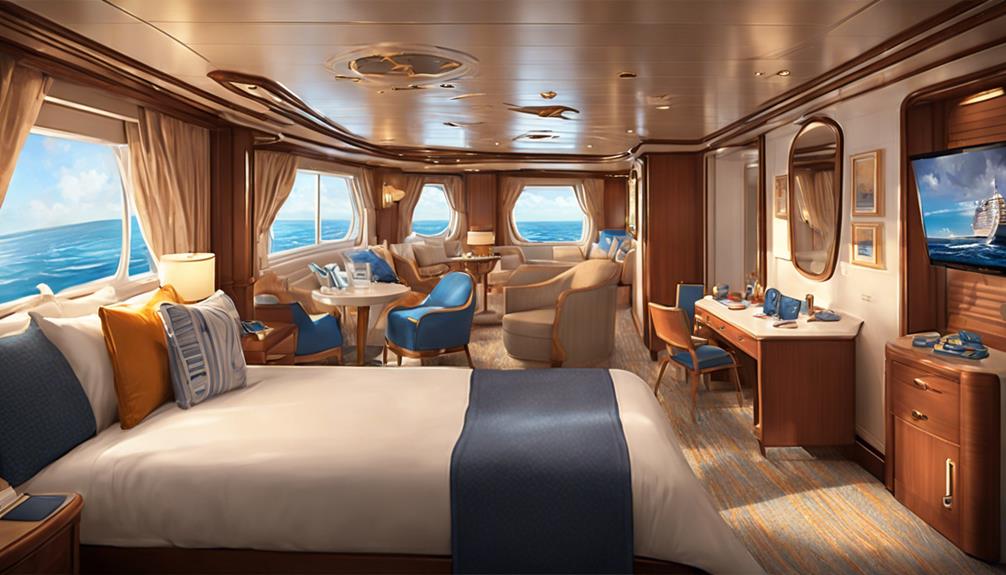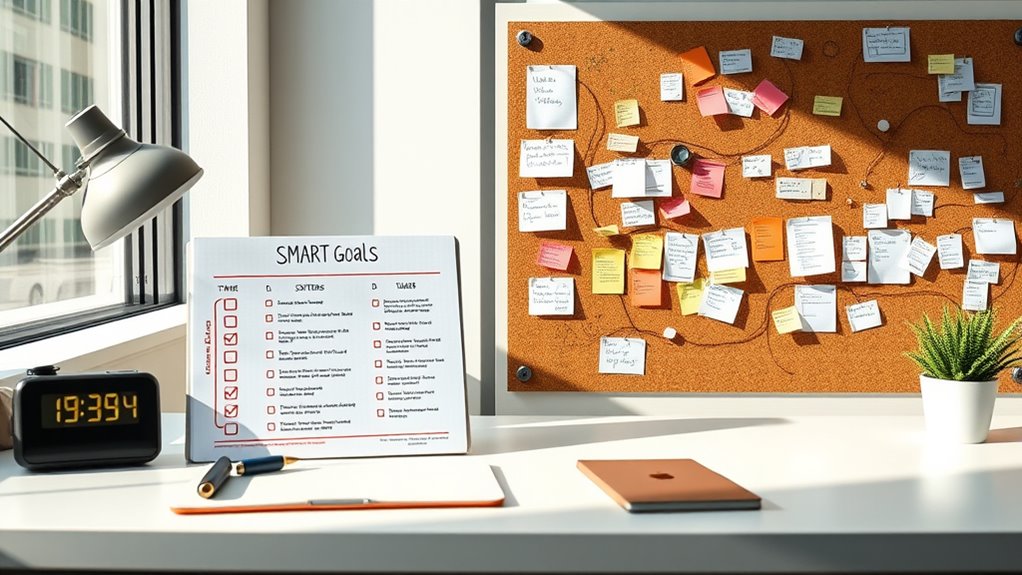For motion sickness relief on the Disney Wish, opt for the mid-ship cabins on lower decks. These areas provide more stability, reducing the rocking sensation that triggers discomfort. Balcony cabins offer fresh air and calming views, assisting in your overall comfort. Consider mid-ship verandah cabins for added stability during your cruise. Exploring different cabin locations can greatly impact how you experience motion at sea. Learn more about the best deck choices for motion sickness relief on the Disney Wish to guarantee a smoother and more enjoyable voyage.
Key Takeaways
- Opt for mid-ship decks for stability during sailing.
- Consider lower decks for reduced motion discomfort.
- Balcony cabins provide fresh air and horizon views.
- Mid-ship verandah cabins offer added stability.
- Use cabin checker tools for optimal motion sickness management.
Motion Sickness Relief on Disney Wish
To minimize motion sickness on the Disney Wish, consider staying on Decks 6 and 7 for their central location and stability. These mid-ship cabins on the Disney Cruise Line offer a smoother sailing experience, reducing the chances of feeling seasick. Being closer to the middle of the ship helps to decrease the sensation of motion, making it an ideal choice for those prone to motion sickness.
The central location of Decks 6 and 7 on the Disney Wish provides a more stable ride as they're less affected by the rocking motion typically felt on higher or lower decks. This strategic positioning can help alleviate any discomfort caused by the ship's movement, ensuring a more enjoyable cruise experience.
When sailing on the Disney Wish, motion sickness can be influenced by factors such as the ship's speed, itinerary, and weather conditions. Opting for a cabin on Deck 6 or 7 mid-ship can contribute to a smoother journey, minimizing the impact of these variables on your comfort levels.
Best Deck Selection for Stability

For enhanced stability and minimized motion on the Disney Wish, consider selecting cabins on Deck 6 or 7. These decks would be better suited for individuals prone to motion sickness, as lower mid-ship cabins are known for reducing the feeling of motion.
The motion experienced on a cruise ship can be influenced by factors such as ship speed, itinerary, and weather conditions. Opting for lower decks can help enhance stability and comfort for guests seeking a smoother sailing experience with reduced motion.
Choosing cabins located in the mid-ship areas on Deck 6 or 7 would provide a more stable environment compared to cabins situated towards the front or back of the ship. By staying in these central decks, you can better mitigate the effects of potential motion discomfort.
Optimal Cabin Location Suggestions

When selecting your cabin on the Disney Wish, keep in mind the benefits of mid-ship locations for stability and motion sickness relief.
Opting for a cabin with a veranda can enhance your experience by providing fresh air and a calming view of the horizon.
Prioritizing these factors can help guarantee a more comfortable and enjoyable cruise on the Disney Wish.
Mid-Ship Stability Benefits
Consider booking mid-ship cabins on decks 4 or 5 for enhanced stability and reduced motion sickness relief on the Disney Wish. Opting for these mid-ship locations can notably decrease the likelihood of experiencing motion discomfort while sailing. By choosing a cabin in the middle of the ship, you're positioned closer to the ship's central axis, where the rocking motion is minimal compared to cabins located at the front or back of the ship.
Staying in a mid-ship cabin on decks 4 or 5 provides a smoother sailing experience, making it an ideal choice for those prone to motion sensitivity. The strategic placement of these cabins helps to stabilize your surroundings and diminish the feeling of being at sea. If motion sickness does occur, prioritize looking at the horizon and getting fresh air from a veranda, if available, to alleviate symptoms.
Veranda Cabin Advantage
Enhance your cruise experience on the Disney Wish by selecting a Veranda category cabin, particularly those situated mid-ship on decks 4 or 5, for best relief from motion discomfort.
- Optimal Location: Veranda cabins located mid-ship on decks 4 or 5 offer stability and minimize the feeling of motion, providing a more comfortable experience for those prone to seasickness.
- Outside Views: Choosing a cabin with a veranda and a view of the horizon can help alleviate symptoms of motion sickness by providing a visual reference point and connection to the outside environment.
- Fresh Air Benefits: Access to fresh air on a veranda allows you to step outside and breathe in the sea air, which can help combat feelings of nausea and dizziness associated with motion sickness.
- Sense of Stability: The ability to step out onto a veranda can offer a sense of stability and control, contributing to a more enjoyable and relaxing cruise experience while managing motion discomfort effectively.
Utilizing Outside Cabins for Relief

When booking your cabin on the Disney Wish, opting for an outside cabin with a veranda can be a game-changer for motion sickness relief.
The balcony benefits of fresh air and a horizon view provide a comfortable outdoor option that can help alleviate any discomfort caused by motion.
Balcony Benefits
Enjoy the benefits of balcony cabins on the Disney Wish for natural relief from motion sickness. When opting for an outside cabin with a balcony, you can take advantage of various perks that contribute to easing motion discomfort:
- Fresh Air and Horizon View:
Balconies provide a source of fresh air and a panoramic view of the horizon, which can help alleviate symptoms of motion sickness.
- Private Outdoor Space:
Having a balcony offers a private outdoor area where you can relax, breathe in the sea breeze, and experience a greater sense of stability.
- Openness and Connection:
Stepping onto a balcony allows you to feel more connected to the surroundings, fostering a sense of openness that may reduce queasiness.
- Comfortable Environment:
Accessing natural light and fresh air from a balcony can help create a more comfortable setting for individuals prone to motion sickness, offering a tranquil retreat to unwind and potentially mitigate the effects of motion discomfort.
Outdoor Comfort Option
Consider utilizing outside cabins with verandas on the Disney Wish for a comfortable outdoor retreat to alleviate motion sickness symptoms. These cabins offer a serene outdoor space where you can enjoy fresh air and a calming view of the horizon, which can help ease feelings of nausea and discomfort caused by motion sickness.
By opting for an outside cabin with a veranda, you'll benefit from a sense of openness and freedom that can reduce the sensation of being confined on a moving ship. The outdoor setting of verandas provides a stable environment that may contribute to a more soothing experience for those prone to motion discomfort.
Utilizing these outside cabins allows you to bask in natural light, enjoy the gentle breeze, and take in the sights and sounds of the sea, all of which can aid in alleviating symptoms of motion sickness while cruising on the Disney Wish.
Alleviating Motion Discomfort
For optimum relief from motion discomfort on the Disney Wish, prioritize selecting mid-ship exterior staterooms with balconies on decks 4/5. These staterooms offer stability and comfort to help alleviate symptoms of motion sickness effectively.
Here are four key reasons why these staterooms are your best option for a smoother sailing experience:
- Balconies Provide Fresh Air: Verandas allow for fresh air circulation, which can help combat sensations of nausea and dizziness linked to motion sickness.
- Horizon Views Aid in Alleviation: Being able to see the horizon from your stateroom can provide a visual reference point that may reduce sensations of disorientation and queasiness.
- Natural Light in Exterior Staterooms: Choosing an exterior stateroom ensures access to natural light, which can contribute to a greater sense of spatial awareness and potentially lessen motion discomfort.
- Mid-Ship Location Stability: Mid-ship staterooms experience less movement than forward or aft staterooms, making them a more suitable choice for individuals prone to motion sickness.
Benefits of Fresh Air and Views

Inhaling the crisp breeze and savoring the panoramic sea views from a verandah cabin can greatly alleviate symptoms of motion sickness by enhancing your sense of space and relaxation. The invigorating air circulating on the balcony provides a welcome escape from the enclosed spaces inside the ship, offering a breath that can help combat feelings of nausea.
Additionally, the private outdoor space allows you to enjoy the sea breeze, promoting comfort and reducing the impact of motion discomfort. Natural light streaming in and the expansive views of the ocean create a serene atmosphere, fostering a sense of calmness that can make your cruising experience more enjoyable.
Leveraging Mid-Ship Verandah Cabins

To minimize motion sickness on the Disney Wish, opting for mid-ship verandah cabins on decks 6 and 7 is highly recommended. These cabins offer a more stable experience due to their central location on the ship.
Here are some reasons why leveraging mid-ship verandah cabins can help alleviate motion sickness:
- Central Location: Mid-ship cabins are strategically positioned in the middle of the ship, where the rocking motion is typically less pronounced.
- Balcony Access: Enjoy fresh air and scenic views from your private verandah, which can help combat feelings of nausea.
- Less Movement: Being closer to the ship's center of gravity means you'll experience fewer abrupt movements, reducing the likelihood of motion sickness.
- Comfortable Environment: Choosing a mid-ship verandah cabin provides a tranquil setting, allowing you to relax and unwind without the disturbance of excessive motion.
Cabin Checker Tools for Guidance

Explore how cabin checker tools on the Disney Wish can assist you in selecting the ideal cabin to minimize motion sickness and enhance your cruise experience. These tools provide detailed information on cabin locations, amenities, and proximity to potential sources of noise or motion.
By utilizing cabin checker tools, you can make informed decisions to alleviate motion sickness concerns on your cruise. They offer insights into the best deck options for minimizing motion sickness, allowing you to select mid-ship cabins on lower decks for enhanced stability and comfort.
With the help of cabin checker tools, guests can identify quiet and motion-free cabin options on Disney Wish, ensuring a more enjoyable cruise experience. Take advantage of these tools to find cabins that suit your preferences and needs, ultimately creating a supportive environment for a smoother sailing experience.
Creating a Supportive Environment

Connect with fellow travelers on your Disney Wish cruise to share experiences and tips for managing motion sickness in a supportive environment. Engaging with other guests can provide valuable insights and strategies for dealing with motion discomfort during rough sea conditions.
By utilizing online forums and social media groups, you can connect with like-minded individuals seeking advice on alleviating motion sickness while cruising. Seeking out support from fellow passengers who've dealt with similar challenges can offer practical remedies and coping mechanisms.
Additionally, joining organized activities or discussions onboard can provide opportunities to gather additional tips and support from experienced cruisers familiar with managing motion sickness.
Frequently Asked Questions
Which Deck on Cruise Ship Is Best for Motion Sickness?
For motion sickness relief on a cruise ship, opt for mid-ship decks like 6 and 7. These locations offer stability and reduce discomfort from ship movement.
Consider mid-ship cabins on decks 4 and 5 for added relief. Avoid forward cabins that may experience more motion or aft cabins with potential engine vibrations.
Take into account ship speed, itinerary, and weather conditions when choosing a cabin to help prevent motion sickness.
Which Deck Is Better on Disney Wish?
For motion sickness relief on the Disney Wish, opt for mid-ship decks like 6 or 7. These decks offer a stable sailing experience, ideal for guests prone to seasickness.
Cabins on higher decks may result in more motion, whereas lower decks provide a smoother cruise. To minimize discomfort, choose a mid-ship cabin on Deck 6 or 7 for a comfortable and enjoyable voyage.
Which Stateroom Is Best for Motion Sickness?
For motion sickness relief on the Disney Wish, seek stateroom serenity on mid-ship decks. Best options include outside cabins with verandas.
Verandas provide fresh air and views, aiding in easing symptoms of motion sickness. Avoid cabins near the front or back of the ship to minimize motion sensation.
Secure stability and comfort by selecting mid-ship staterooms on lower decks. Choose wisely for a smoother sailing experience onboard the Disney Wish.
Is Deck 8 Good on Disney Wish?
Deck 8 on Disney Wish is a great choice for those worried about motion sickness. Many guests have reported minimal motion and a tranquil atmosphere in specific cabins, making it an ideal option for a comfortable cruise experience. Additionally, Deck 8 offers convenient access to the spa and relaxation areas, making it the ultimate relaxation spot for guests looking to unwind and rejuvenate. With its serene surroundings and minimal movement, it’s no wonder why Deck 8 is a popular choice for those seeking a peaceful and enjoyable cruise. Whether you’re lounging by the pool or indulging in a spa treatment, Deck 8 provides the perfect setting for a truly tranquil vacation experience.
Choosing a cabin on Deck 8 can provide relief from motion discomfort and secure a peaceful environment, contributing to a more enjoyable journey overall.
Consider Deck 8 for a soothing and motion-free stay on the Disney Wish.
Conclusion
So there you have it – the best deck on Disney Wish for motion sickness relief!
With the perfect cabin location and fresh air to keep you feeling steady, you'll forget all about those pesky waves.
Say goodbye to seasickness and hello to smooth sailing – Disney Wish has got you covered!









